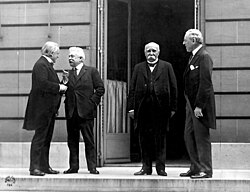| |||||
| Decades: | |||||
|---|---|---|---|---|---|
| See also: | |||||
Events from the year 1919 in Italy .
| |||||
| Decades: | |||||
|---|---|---|---|---|---|
| See also: | |||||
Events from the year 1919 in Italy .
The years 1919 and 1920 were known as the Biennio Rosso (English: "Red Biennium"): a two-year period of intense social conflict and political unrest in Italy, following the First World War. The revolutionary period and nationalist agitation on the Mutilated victory and the failure to obtain territorial concessions in Dalmatia at the end of World War I to fulfil Italy’s irredentist claims, was followed by the violent reaction of the Fascist blackshirts militia, the most brutal of which were the Cremona squads organized by Roberto Farinacci to terrorize the Italian population into submission to Fascism, and eventually by the March on Rome of Benito Mussolini in 1922.


